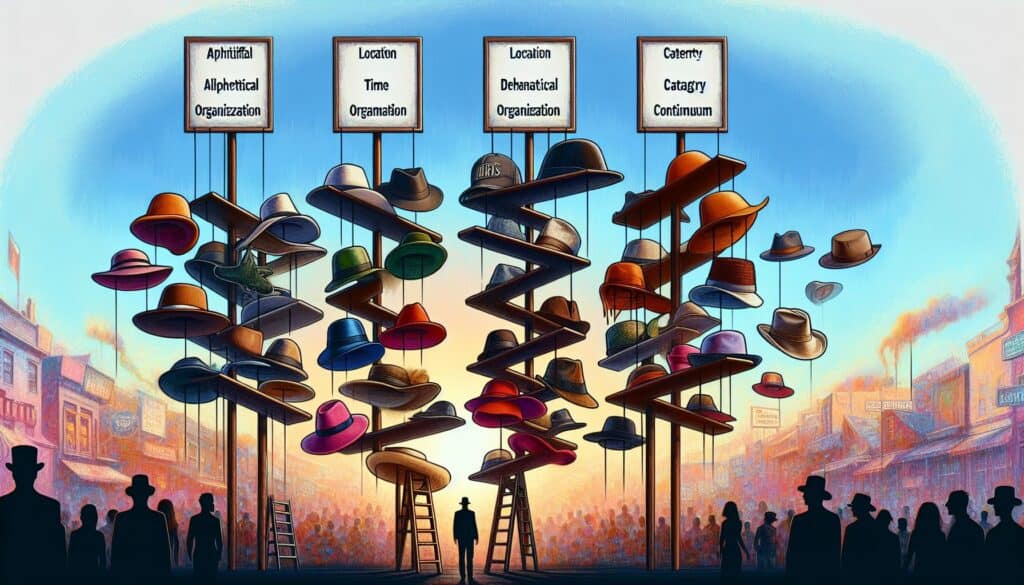Proporcionar un estructura of five fundamental ways to organize information: Location, Alphabet, Time, Category, and Hierarchy (or Continuum).
- Metodologías: Clientes y marketing, Ideación, Diseño de producto
Five Hat Racks (LATCH)

Five Hat Racks (LATCH)
- Metodología ágil, Pensamiento de diseño, Arquitectura de la información, Mejora de procesos, Gestión de proyectos, Usabilidad, Pruebas de usabilidad, Experiencia de usuario (UX), Interfaz de usuario (UI)
Objetivo:
Cómo se utiliza:
- When designing information systems, interfaces, or content, information is structured using one or more of these organizational schemes to make it findable and understandable for users.
Ventajas
- Offers simple and intuitive ways to structure information, applicable to a wide variety of content and contexts, helps create logical and user-friendly information architectures.
Contras
- Can be too simplistic for highly complex information sets, choosing the most appropriate 'rack' can sometimes be ambiguous, may require a combination of methods for optimal organization.
Categorías:
- Clientes y marketing, Ergonomía, Diseño de producto
Ideal para:
- Organizing information in websites, applications, documents, and physical spaces to improve usability, navigation, and comprehension.
Five Hat Racks (LATCH) is particularly beneficial in sectors like e-commerce, education, healthcare, and any field requiring effective information presentation. For instance, in e-commerce platforms, categorizing products based on location, alphabet, time, category, or hierarchy allows users to swiftly find items, enhancing their shopping experience and potentially increasing sales. In educational applications, organizing materials by audience, such as students or teachers, ensures relevant content is easily accessible. In healthcare, patient information systems can utilize LATCH frameworks to filter data efficiently, aiding healthcare professionals in rapid decision-making. This methodology can be initiated by designers, information architects, or project managers during the early phases of system or interface design, fostering collaboration across disciplines, including UX/UI design and content strategy, ensuring that all relevant stakeholders contribute to the structure of the information. In contexts like workshops or brainstorming sessions, participants can collectively assess the most appropriate organizing principles by visually mapping content and user needs. Utilizing LATCH not only provides an intuitive structure but also makes the arquitectura de la información adaptable to various design processes, leading to better user satisfaction and engagement across diverse platforms and environments.
Pasos clave de esta metodología
- Identify the types of data or content you have.
- Choose the appropriate organizational scheme from the LATCH categories: Location, Alphabet, Time, Category, and Hierarchy.
- Map the content onto the chosen scheme, ensuring it aligns logically with user needs.
- Test the structure with potential users to gather feedback on usability and navigation.
- Refine the information architecture based on user feedback and observations.
- Implement the structured information into the design of the system or interface.
- Monitor user interaction to continually assess the effectiveness of the information organization.
Consejos profesionales
- Utilize LATCH in a hierarchical manner, starting with the most relevant layer of information to establish a clear path for users.
- Combine multiple LATCH components for cross-referencing, enhancing depth without overwhelming users by maintaining clarity in primary navigation.
- Regularly test LATCH structures with real users in context, adjusting based on feedback to ensure that the organization meets evolving user needs.
Leer y comparar varias metodologías, recomendamos el
> Amplio repositorio de metodologías <
junto con otras más de 400 metodologías.
Sus comentarios sobre esta metodología o información adicional son bienvenidos en la dirección sección de comentarios ↓ , así como cualquier idea o enlace relacionado con la ingeniería.
Contexto histórico
1960
1980
1983
1990
1995
2000
2010
1950
1980
1980
1986
1994
1995
2000
(si se desconoce la fecha o no es relevante, por ejemplo "mecánica de fluidos", se ofrece una estimación redondeada de su notable aparición)














Publicaciones relacionadas
Calculadora de METS a calorías
Metaanálisis
Asignación de mensajes
Diagramas de modelos mentales
Fuerzas de empuje y tracción máximas admisibles
Planificación de necesidades de material (MRP)